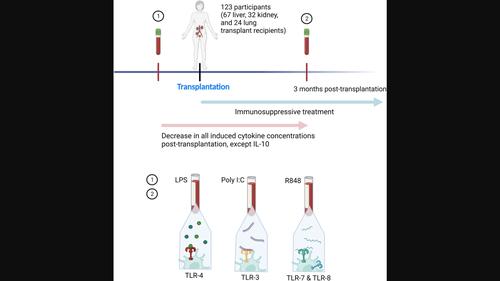Differences in toll-like receptor ligand-induced cytokine concentrations before and after solid organ transplantation: A prospective, observational cohort study in a clinical setting
Dina Leth Møller, Søren Schwartz Sørensen, Michael Perch, Finn Gustafsson, Annemette Hald, Andreas Delhbæk Knudsen, Ranya Abdulovski, Nicoline Stender Arentoft, Jens Lundgren, Allan Rasmussen, Sisse Rye Ostrowski, Susanne Dam Nielsen
求助PDF
{"title":"Differences in toll-like receptor ligand-induced cytokine concentrations before and after solid organ transplantation: A prospective, observational cohort study in a clinical setting","authors":"Dina Leth Møller, Søren Schwartz Sørensen, Michael Perch, Finn Gustafsson, Annemette Hald, Andreas Delhbæk Knudsen, Ranya Abdulovski, Nicoline Stender Arentoft, Jens Lundgren, Allan Rasmussen, Sisse Rye Ostrowski, Susanne Dam Nielsen","doi":"10.1111/sji.13337","DOIUrl":null,"url":null,"abstract":"Reliable methods to assess immune function after solid organ transplantation (SOT) are needed to guide dosing of immunosuppression. We hypothesized that toll-like receptor ligand-induced cytokine concentrations would decrease post-transplantation due to the use of immunosuppressive medication. Furthermore, we hypothesized that induced cytokine concentrations pre-transplantation would be higher in recipients with episodes of acute rejection post-transplantation due to underlying immunological dispositions. We aimed to investigate toll-like receptor ligand-induced cytokine concentrations by TruCulture©, a standardized immunoassay, in SOT recipients before and 3 months after SOT and explored associations with methylprednisolone-treated acute rejections. We conducted a prospective, observational cohort study including 123 participants (67 liver, 32 kidney and 24 lung transplant recipients). Whole blood was stimulated for 22 h with: (A) Lipopolysaccharide (LPS), (B) Resiquimod, (C) Polyinosinic:polycytidylic acid (Poly I:C) and (D) a blank control. Cytokine concentrations (TNF-α, IL-1β, IL-6, IL-8, IL-10, IL-12p40, IL-17A, IFN-α and IFN-γ) were measured by Luminex. 30 participants developed methylprednisolone-treated acute rejection at a median of 9 days (IQR 5–17) post-SOT. We found that all induced cytokine concentrations decreased post-SOT except from LPS-induced and Poly I:C-induced IL-10. The induced cytokine concentration pre-transplantation did not differ in recipients with or without acute rejection. In conclusion, the induced cytokine concentrations decreased for all stimuli post-SOT, except the anti-inflammatory cytokine IL-10. Importantly, recipients developing early acute rejection did not differ in induced cytokine concentrations pre-SOT. Thus, the use of a standardized assay in SOT is feasible in a clinical setting and may provide important information on the immune function post-SOT.","PeriodicalId":21493,"journal":{"name":"Scandinavian Journal of Immunology","volume":"45 5","pages":""},"PeriodicalIF":4.1000,"publicationDate":"2023-11-20","publicationTypes":"Journal Article","fieldsOfStudy":null,"isOpenAccess":false,"openAccessPdf":"","citationCount":"0","resultStr":null,"platform":"Semanticscholar","paperid":null,"PeriodicalName":"Scandinavian Journal of Immunology","FirstCategoryId":"3","ListUrlMain":"https://doi.org/10.1111/sji.13337","RegionNum":4,"RegionCategory":"医学","ArticlePicture":[],"TitleCN":null,"AbstractTextCN":null,"PMCID":null,"EPubDate":"","PubModel":"","JCR":"Q2","JCRName":"IMMUNOLOGY","Score":null,"Total":0}
引用次数: 0
引用
批量引用
Abstract
Reliable methods to assess immune function after solid organ transplantation (SOT) are needed to guide dosing of immunosuppression. We hypothesized that toll-like receptor ligand-induced cytokine concentrations would decrease post-transplantation due to the use of immunosuppressive medication. Furthermore, we hypothesized that induced cytokine concentrations pre-transplantation would be higher in recipients with episodes of acute rejection post-transplantation due to underlying immunological dispositions. We aimed to investigate toll-like receptor ligand-induced cytokine concentrations by TruCulture©, a standardized immunoassay, in SOT recipients before and 3 months after SOT and explored associations with methylprednisolone-treated acute rejections. We conducted a prospective, observational cohort study including 123 participants (67 liver, 32 kidney and 24 lung transplant recipients). Whole blood was stimulated for 22 h with: (A) Lipopolysaccharide (LPS), (B) Resiquimod, (C) Polyinosinic:polycytidylic acid (Poly I:C) and (D) a blank control. Cytokine concentrations (TNF-α, IL-1β, IL-6, IL-8, IL-10, IL-12p40, IL-17A, IFN-α and IFN-γ) were measured by Luminex. 30 participants developed methylprednisolone-treated acute rejection at a median of 9 days (IQR 5–17) post-SOT. We found that all induced cytokine concentrations decreased post-SOT except from LPS-induced and Poly I:C-induced IL-10. The induced cytokine concentration pre-transplantation did not differ in recipients with or without acute rejection. In conclusion, the induced cytokine concentrations decreased for all stimuli post-SOT, except the anti-inflammatory cytokine IL-10. Importantly, recipients developing early acute rejection did not differ in induced cytokine concentrations pre-SOT. Thus, the use of a standardized assay in SOT is feasible in a clinical setting and may provide important information on the immune function post-SOT.


